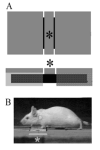The relationship between bone mechanical properties and ground reaction forces in normal and hypermuscular mice
- PMID: 20535766
- PMCID: PMC3666574
- DOI: 10.1002/jez.604
The relationship between bone mechanical properties and ground reaction forces in normal and hypermuscular mice
Abstract
Understanding the relationship between external load and bone morphology is critical for understanding adaptations to load in extant animals and inferring behavior in extinct forms. Yet, the relationship between bony anatomy and load is poorly understood, with empirical studies often producing conflicting results. It is widely assumed in many ecological and paleontological studies that bone size and strength reflect the forces experienced by the bone in vivo. This study examines that assumption by providing preliminary data on gait mechanics in a hypermuscular myostatin-deficient mouse model with highly mineralized and hypertrophied long bones. A small sample of hypermuscular and wild-type mice was video recorded while walking freely across a force platform. Temporal gait parameters, peak vertical and transverse (mediolateral) ground reaction forces (GRFs), vertical impulse, and loading rates were measured. The only gait parameters that differed between the two groups were the speeds at which the animals traveled and the transverse forces on the hind limb. The myostatin-deficient mice move relatively slowly and experienced the same magnitude of vertical forces on all limbs and transverse forces on the forelimb as the wild-type mice; though the myostatin-deficient mice did experience lower mediolateral forces on their hindlimbs compared with the wild-type mice. These preliminary results call into question the hypothesis that skeletal hypertrophy observed in hypermuscular mice is a result of larger GRFs experienced by the animals' limbs during locomotion. This calls for further analysis and a cautious approach to inferences about locomotor behavior derived from bony morphology in extant and fossil species.
(c) 2010 Wiley-Liss, Inc.
Figures







Similar articles
-
Mechanics of limb bone loading during terrestrial locomotion in the green iguana (Iguana iguana) and American alligator (Alligator mississippiensis).J Exp Biol. 2001 Mar;204(Pt 6):1099-122. doi: 10.1242/jeb.204.6.1099. J Exp Biol. 2001. PMID: 11222128
-
Gait mechanics of lemurid primates on terrestrial and arboreal substrates.J Hum Evol. 2005 Feb;48(2):199-217. doi: 10.1016/j.jhevol.2004.11.004. Epub 2005 Jan 12. J Hum Evol. 2005. PMID: 15701531
-
Coordination strategies for limb forces during weight-bearing locomotion in normal rats, and in rats spinalized as neonates.Exp Brain Res. 2008 Sep;190(1):53-69. doi: 10.1007/s00221-008-1451-4. Epub 2008 Jul 9. Exp Brain Res. 2008. PMID: 18612631 Free PMC article.
-
Biomechanical consequences of scaling.J Exp Biol. 2005 May;208(Pt 9):1665-76. doi: 10.1242/jeb.01520. J Exp Biol. 2005. PMID: 15855398 Review.
-
Contributions to the understanding of gait control.Dan Med J. 2014 Apr;61(4):B4823. Dan Med J. 2014. PMID: 24814597 Review.
Cited by
-
Locomotor activity influences muscle architecture and bone growth but not muscle attachment site morphology.J Hum Evol. 2015 Jan;78:91-102. doi: 10.1016/j.jhevol.2014.10.010. Epub 2014 Nov 15. J Hum Evol. 2015. PMID: 25467113 Free PMC article.
-
Effects of High-Fat Diet and Body Mass on Bone Morphology and Mechanical Properties in 1100 Advanced Intercross Mice.J Bone Miner Res. 2019 Apr;34(4):711-725. doi: 10.1002/jbmr.3648. Epub 2019 Jan 7. J Bone Miner Res. 2019. PMID: 30615803 Free PMC article.
-
Effects of selective breeding for voluntary exercise, chronic exercise, and their interaction on muscle attachment site morphology in house mice.J Anat. 2022 Feb;240(2):279-295. doi: 10.1111/joa.13547. Epub 2021 Sep 14. J Anat. 2022. PMID: 34519035 Free PMC article.
-
Mustn1 ablation in skeletal muscle results in functional alterations.FASEB Bioadv. 2023 Nov 15;5(12):541-557. doi: 10.1096/fba.2023-00082. eCollection 2023 Dec. FASEB Bioadv. 2023. PMID: 38094159 Free PMC article.
-
Life-long caloric restriction does not alter the severity of age-related osteoarthritis.Age (Dordr). 2014;36(4):9669. doi: 10.1007/s11357-014-9669-5. Epub 2014 Jul 1. Age (Dordr). 2014. PMID: 24981112 Free PMC article.
References
-
- Alexander RM, Jayes AS, Maloiy GMO, Wathuta EM. Allometry of limb bones of mammals from shrews (Sorex) to elephant (Loxodonta) J Zool Lond. 1979;189:305–314.
-
- Amblard D, Lafange-Proust MH, Laib A, Thomas T, Ruegesegger P, Alexander C, Vito L. Tail suspension induces bone loss in skeletally mature mice in the C57 BL/6J strain but not in the C3H/HeJ strain. J Bone Mineral Res. 2003;18:561–569. - PubMed
-
- Asakura A, Komaki M, Rudnicki M. Muscle satellite cells are multipotential stem cells that exhibit myogenic, osteogenic, and adipogenic differentiation. Differentiation. 2001;68:245–253. - PubMed
-
- Bertram JEA, Biewener AA. Bone curvature: sacrificing strength for load predictability? J Theor Bio. 1988;131:75–92. - PubMed
-
- Bertram JEA, Biewener AA. Differential scaling of the long bones in the terrestrial carnivora and other mammals. J Morph. 1990;204:157–169. - PubMed
Publication types
MeSH terms
Grants and funding
LinkOut - more resources
Full Text Sources
Miscellaneous

